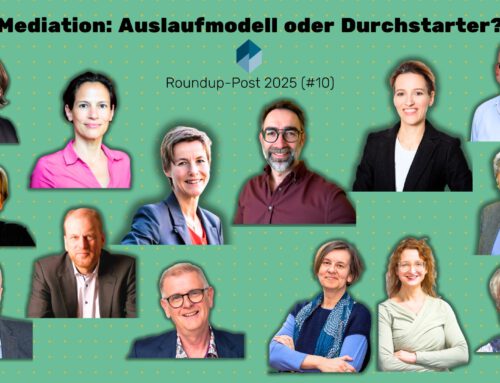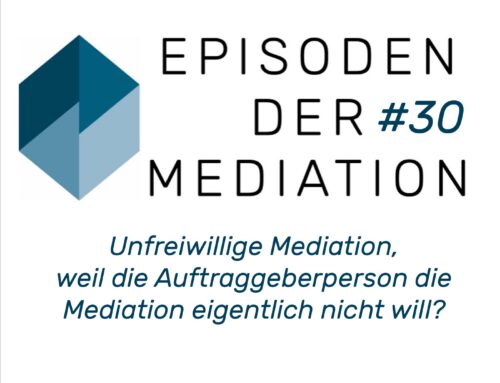#05 EdM – Violence and Mediation I
Manifestations of violence in the context of mediation
What forms of violence are important to distinguish in mediation?
Episodes of mediation. The podcast on practical questions about mediation and conflict management.
Welcome to the EdM,
INKOVEMA's teaching stream on the practical issues of mediation and conflict management.
Practical situations in mediation, but also in coaching and conflict counselling, are explained, reflected upon and categorised.
This is episode 5 – Violence and Mediation. Part I – Manifestations and fields of application
Fields of application:
Violence and mediation are not compatible in principle. But the topic is complex. And challenges mediators. As a lawyer, I taught criminal law for many years and know how fascinating violence is, especially in its repulsive form, which usually provokes a corresponding backlash. It is therefore not surprising that the first reaction in the context of mediation can be: "DON'T DO IT!". And in mediation discussions, the topic of violence is ideally suited to leaving the mediator's post and taking the side of the victims, who are then quickly turned into one side of the conflict parties.
However, it is worth taking a more concrete look at the topic of violence and mediation from the perspective of a safe observer before approaching it from a practical mediation perspective.
Firstly, it seems helpful to me to distinguish between two manifestations with different fields of application:
Violence occurs directly as a form of communication. Two fields of application must be differentiated here:
- During mediation discussions, violence occurs specifically towards the other party to the conflict or the mediator himself – either in the form of physical or psychological violence.
- Violence (possibly) occurs parallel to the mediation discussions. This is not only theoretically conceivable, but sometimes a sad reality in separation and divorce conflicts.
The second manifestation is that violence or violent behaviour comes up in mediation as a description of the conflict by the parties.
- Either a past, violent escalation of conflict is brought up, i.e. remembered – and then either affirmed as a shared memory, or
- the description of violence is denied as such by the other side – it was either completely different or at least not so violent as to justify the term violence as a judgemental memory.
- However, violence can also be threatened in mediation and thus communicated as a future, imminent event. This closes the circle to the first field: the possibility of future acts of violence can come across as a present psychological act of violence.
These five conceptually different fields of application However, in practice, the conceptual differentiation of violence in the context of mediation is by no means as clear as suggested here. However, this blurring at the edges is not problematic as long as the differences at the centre are clearly visible to the mediators.
However, a schematic concept is one thing, schematic behaviour in mediation is quite another. One is necessary in order to maintain a clear overview as a mediator and to come to terms with the situation, the other is not. Schematic, preconceived behaviour does neither mediators nor mediators any good.
Manners What can be said in principle about the individual manifestations of violence in the context of mediation?
to 1.If violence occurs verbally or physically in the course of mediation, then the third party must decide to what extent they can actually be effective mediators and, on the basis of their professionalism, can take responsibility for the principally non-violent mediation process. The legislator sets out the course here in Section 2 (5) sentence 2 MediationsG: "The mediator may terminate the mediation, in particular if he is of the opinion that independent communication or an agreement between the parties cannot be expected."
- If violence or violent language occurs during the mediation discussions, the THIRD PARTY must at least take a THINKING BREAK IN THE FORM OF AN INTERRUPTION in order to escape the emotional pull of such a situation and to think about cancelling the mediation for the moment or ending it permanently. This decision can, of course, be made later if necessary. In NO case should it be passed over in silence (=cool). Confrontation by the mediator is required here, i.e. the SHOWING OF RESISTANCE to deal with the conflict on one's own responsibility and to use force (restriction of the other party's personal responsibility) in the process.
- If violence (possibly) occurs parallel to mediation, e.g. in separation and divorce mediation, then this must first be recognised and mediation decisions made on this basis. It is therefore important not to close your eyes to such realities, i.e. to consider them an impossibility, but to recognise them: Just because it is mediators who want to make use of our non-violent services does not mean that other realities become impossible. It is then important to realise the complexity of the request, to face up to the task with knowledge, other experiences and supervisory powers, insofar as you are prepared to accept such a task. Not every mediator would do this, but I would not advise against it in general. (Recommended reading: Ulla Gläßer, Mediation und Beziehungsgewalt. Möglichkeiten, Bedingungen und Grenzen des Einsatzes von Familienmediationen bei Gewalt in Paarbeziehungen, Baden Baden 2008).
to 2.If there are descriptions of violence in the mediation or in the mediation discussions, i.e. violence is remembered and communicated as such, then it is important to first explore the memories and assessments that the other party has about this. After all, memory reflects the present, as historians so succinctly put it.
And that means the following here:
- If the other party remembers the violence differently and de facto denies it, it is important to proceed with particular caution, as "missteps are immediately penalised". The neutrality and impartiality of the mediator and the mediation method as a whole are put to the test in a dispute over the classification of past behaviour as violence or non-violence. Does the mediator – objectify the facts of the case and make a "democratic" assessment as violence or non-violence, or is it a matter of dealing constructively with different perspectives and memories, with each side having to make decisions about the relationship based on their own truth? In principle, there is no need to compare what has actually happened for everyone. In the next instalment, I will look at how this case could actually unfold and what mediators can or should not do here. For now, I'll leave it at that.
- If the alleged violence is communicated by one side and not denied by the other side, the mediation will then focus on the possible need to apologise, so that the mediator must encourage and initiate a communication of apology. More on this in a later episode.
- If violence is communicated as a possible future event, then it is a threat if this event depends on the person communicating it (motto: "If you don't stop..., then I will [use violence]..."). As a threatening act of violence, this is also to be understood as current psychological violence and, as described above, should be marked as a contradiction to the mediator's own intentions and, if necessary, the mediation should be terminated by the mediator.
Next time
That's it for this time – and I hope this has been an easy-to-understand overview of the manifestations of violence in the context of mediation.
Next time, I will go into more detail here on how disputed memories of violence between conflict parties can be dealt with mediatively and – probably then another episode – how apology communications are initiated in the case of undisputed memories of violence by the mediators.
For now, thank you for joining us again.
Stay with us and get through this time well.
Yours, Sascha Weigel.





Leave A Comment